1 of 6
Download to read offline
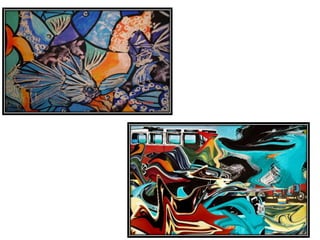
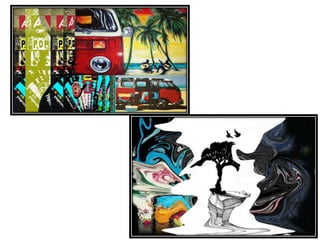
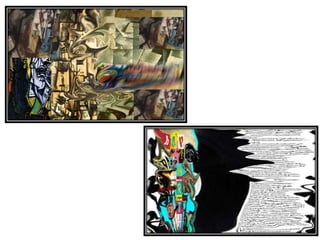
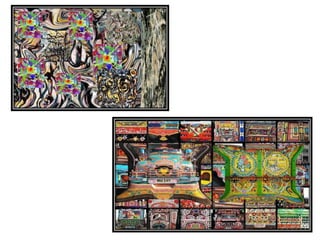
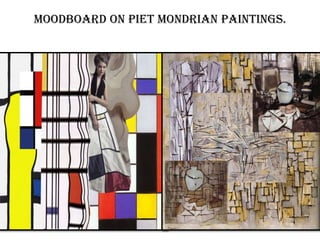
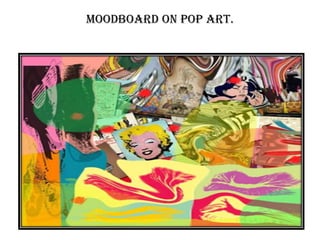
Ad
Recommended
LO3 - Lesson 1 - Mood Boards
LO3 - Lesson 1 - Mood BoardsThe English Martyrs School & Sixth Form College
╠²
Mood boards visually illustrate ideas and concepts by collecting relevant assets like photos, fabrics, and colors. They help generate concepts for a specific style. Mood boards can be created physically with pins on a board or digitally using design software. This lesson teaches how to understand the purpose of mood boards, know how to select suitable assets, and create an electronic mood board on the theme of Great Britain or the USA including flags, colors, landmarks, people, food, and brands.LO1 - Lesson 1 - Introduction
LO1 - Lesson 1 - IntroductionThe English Martyrs School & Sixth Form College
╠²
The document provides an introduction to the Cambridge Nationals in Creative iMedia course. It discusses that the course will develop skills using industry standard software like Adobe. It also outlines that students will need to complete four units, including one exam and three coursework units, to pass the course. They will learn about pre-production skills, digital graphics, comic book creation, and game design.How to make fashion mood board
How to make fashion mood boardsuniltalekar1
╠²
The document outlines the fundamental elements of fashion, focusing on haute couture, designer labels, and mass market clothing, along with seasonal trends and the design process. It explains how designers predict trends, develop themes for collections, and create mood boards to visually communicate their inspiration. Additionally, it details the steps involved in designing garments, from the initial concept to the final presentation at fashion shows.My Fashion portfolio
My Fashion portfoliomehtabbadwal
╠²
Mehtab's Fashion portfolio documents various themes for a clothing collection including Indian Traditional, Western, Summer, Flower Power, Winter, Black and White, True Blue, Animal Prints, and Miscellaneous. It includes mood boards, collections, sketches, flats, and swatches of fabrics like cotton, silk, polyester, viscose, linen, nylon, rayon, taffeta, chiffon, georgette, velvet, corduroy, fur, and different weaves. The portfolio provides visual research and inspiration for a diverse line of clothing.Sewing
Sewinghamzasiddique
╠²
This document outlines the contents of a sewing course, including techniques like straight lines, pin tucks, pockets, stitches, hemming, sleeves and cuffs. It discusses applying buttons, fasteners, hooks and eyes. Different types of fusings are explained. Research is presented on fabrics, hems, linings and closures like invisible zips, velcro, regular zips, drawstrings and buttons. Bodice and skirt linings for dresses and jackets are covered.Pattern
Patternhamzasiddique
╠²
This document provides patterns and instructions for various garment components including cuffs, pockets, collars, sleeves, and skirts. It includes the basic patterns for a cuff block, pocket, one-piece and two-piece collars, basic and semi-fitted sleeves, and basic skirt block. Instructions are provided on how to draft each pattern with measurements and notations. Variations like knife pleat and box pleat skirts are also included. The document serves as a reference for basic garment patternmaking.Reports
Reportshamzasiddique
╠²
- Teejays was a pioneering Pakistani designer who helped establish fashion as an industry in Pakistan in the 1970s through his work on television dramas.
- The report discusses how Teejays feels today's designers have not changed the country's look and should focus on erasing boundaries rather than creating them.
- It also discusses Teejays' plans to return to the fashion industry soon with a new vision.Final presentation
Final presentationhamzasiddique
╠²
The document discusses how western fashion has influenced clothing styles in Pakistan. It provides details on traditional Pakistani clothing like the salwar kameez as well as how western brands and designers have become popular. Major fashion hubs in other parts of the world like New York, London, Milan, and Paris are mentioned along with prominent designers that have global influence. Local Pakistani designers are also discussed who take inspiration from western fashion trends.Fashion design 2
Fashion design 2hamzasiddique
╠²
This document outlines the requirements and deliverables for the final collection portion of the 1st year of study at the Institute of Professional Development. Students must complete rough sketches, renderings including 3 final renders, stitching, moodboards, research boards on the artist Piet Mondrian as well as his work, and fabric swatches. They also need to provide references used which include websites and books.Fashion promotion
Fashion promotionhamzasiddique
╠²
The document outlines assignments for graphic design courses including creating a brochure design for college using Adobe Photoshop showing applied elements and techniques, making moodboards on Op Art and Pop Art styles with research into their history, designing a fashion brand with a moodboard, logo, and visiting cards. It provides instructions for multiple projects exploring graphic design techniques and styles.Fashion drawing 3
Fashion drawing 3hamzasiddique
╠²
This document outlines assignments for various fashion and art courses including mood boards, sketches, and final designs related to topics like the military, beachwear, Gothic art, belly dancing, a local brand, evening wear, night clubs, and variations in clothing elements. It provides instructions for assignments on baby dolls, hip hop outfits, and researching and designing based on a selected local brand. References and bibliographic sources are also listed at the end.Fashion design 2
Fashion design 2hamzasiddique
╠²
This document outlines the requirements and deliverables for the final collection portion of the 1st year of study at the Institute of Professional Development. Students must complete rough sketches, renderings including 3 final renders, stitching, moodboards, research boards on the artist Piet Mondrian as well as his work, and fabric swatches. They also need to provide references using various sources such as Google, Yahoo, books, and Wikipedia to complete their research.Textile design and printing.
Textile design and printing.hamzasiddique
╠²
This document summarizes an assignment for a textile design student named Hamza Siddique. The assignment involved remaking a previous design and developing a design based on an ethnic theme. It describes including a color palette, final design, negatives, and 3D design effects. It also lists different printing and beading techniques used on fabric panels like screen printing, foil printing, and embroidery. These techniques were applied to fabrics like fleece, cotton, and jersey.Textile work
Textile workhamzasiddique
╠²
Mosaic is an art form that creates images using small pieces of materials like glass, stone or other items. These small pieces, called tesserae, are arranged to form patterns or pictures. The document then discusses fish, describing them as aquatic animals covered in scales with fins and gills. It provides details on where different types of fish can be found. The next section defines drugs broadly as substances that alter normal body function when absorbed. It distinguishes between prescribed drugs, recreational drugs, and how some can be addictive. The remaining document discusses various textile design techniques like tie dye, batik designs, weaving and screen printing.Textile and material understanding
Textile and material understandinghamzasiddique
╠²
The document discusses different types of fibers used in textiles, including natural fibers like cotton, wool, silk and manufactured fibers like nylon, polyester, and rayon. It provides details on the characteristics and uses of specific fibers like cashmere, linen, mohair and acrylic. Both natural and manufactured fibers are discussed in terms of their properties, production methods, and applications in apparel and home textiles.Geometrical textile design
Geometrical textile designhamzasiddique
╠²
Hamza Siddique completed a geometrical textile design and mapping final project for his CAD unit. He researched geometrical shapes, developed different design repeats, rendered a final design, and printed an A-3 version. His final product was a textile design created on Adobe Photoshop that incorporated geometrical shapes, repeats, rendering, and 3D effects as part of his assignment to design a mapped textile pattern using CAD software.Live projects and modeling
Live projects and modelinghamzasiddique
╠²
The document mentions several projects the student has worked on including designing outfits for a western themed photoshoot, creating a gothic-style outfit for a fashion show using leather materials, and designing four outfits inspired by YSL that were selected for an Asian lifestyle show. Photography for the last project was done in London.Sketching, painting and moodboards
Sketching, painting and moodboardshamzasiddique
╠²
The document discusses different types of art mediums and materials including water colors, oil paints, paintings, poster paints with a green/white theme, pastel work, textile prints, and moodboards with themes of Africa, black and white, and mafia.Shoes & accessories
Shoes & accessorieshamzasiddique
╠²
This document describes items of clothing, art supplies, and accessories. It mentions a scarf and tie made using oil paints in a design. It also refers to a luggage bag and jewellery.Assignment
Assignmenthamzasiddique
╠²
Cubism was sparked in 1907 by Pablo Picasso and Georges Braque, breaking up subjects and reassembling them in abstract forms from multiple angles simultaneously. There were three stages: Facet Cubism used simplified forms; Analytic Cubism used planes and edges; Synthetic Cubism had uniform brushstrokes creating light vibrations. Even after Braque and Picasso stopped working together during World War 1, cubism remained active into the 1920s. Research and development included boards, sketches, garment construction, and fabric samples for a project exploring Picasso and cubism.Dissertation report
Dissertation reporthamzasiddique
╠²
This document provides an overview of fashion history from several regions and designers. It discusses the history of French, British, American, and Italian fashion design. For French design, it mentions Yves Saint Laurent and Givenchy. For British design, it discusses Alexander McQueen and John Galliano. American design highlights Calvin Klein. Italian houses covered include Versace, Prada, and Giorgio Armani. The document also provides a brief introduction to fashion history in Pakistan.Business report
Business reporthamzasiddique
╠²
This document contains a business plan for launching a new clothing brand focused on caps and belts. It outlines the products, target markets, raw materials, advertising strategy, and costing analysis. The key points are:
1) The products will be caps and belts for men and women in a range of designs and colors.
2) The target market is people of all ages, targeting both upper and middle classes.
3) Quality materials like leather, cotton, wool and silk will be used while keeping costs low.
4) Advertising will include television, newspapers and online to promote the brand widely.Embroidery & embellishments
Embroidery & embellishmentshamzasiddique
╠²
Embroidery work involves embellishing fabric like jersey with beads. Beads are used to embellish jersey fabric through embroidery work. The document discusses bead embroidery work done on jersey fabric.More Related Content
More from hamzasiddique (18)
Fashion design 2
Fashion design 2hamzasiddique
╠²
This document outlines the requirements and deliverables for the final collection portion of the 1st year of study at the Institute of Professional Development. Students must complete rough sketches, renderings including 3 final renders, stitching, moodboards, research boards on the artist Piet Mondrian as well as his work, and fabric swatches. They also need to provide references used which include websites and books.Fashion promotion
Fashion promotionhamzasiddique
╠²
The document outlines assignments for graphic design courses including creating a brochure design for college using Adobe Photoshop showing applied elements and techniques, making moodboards on Op Art and Pop Art styles with research into their history, designing a fashion brand with a moodboard, logo, and visiting cards. It provides instructions for multiple projects exploring graphic design techniques and styles.Fashion drawing 3
Fashion drawing 3hamzasiddique
╠²
This document outlines assignments for various fashion and art courses including mood boards, sketches, and final designs related to topics like the military, beachwear, Gothic art, belly dancing, a local brand, evening wear, night clubs, and variations in clothing elements. It provides instructions for assignments on baby dolls, hip hop outfits, and researching and designing based on a selected local brand. References and bibliographic sources are also listed at the end.Fashion design 2
Fashion design 2hamzasiddique
╠²
This document outlines the requirements and deliverables for the final collection portion of the 1st year of study at the Institute of Professional Development. Students must complete rough sketches, renderings including 3 final renders, stitching, moodboards, research boards on the artist Piet Mondrian as well as his work, and fabric swatches. They also need to provide references using various sources such as Google, Yahoo, books, and Wikipedia to complete their research.Textile design and printing.
Textile design and printing.hamzasiddique
╠²
This document summarizes an assignment for a textile design student named Hamza Siddique. The assignment involved remaking a previous design and developing a design based on an ethnic theme. It describes including a color palette, final design, negatives, and 3D design effects. It also lists different printing and beading techniques used on fabric panels like screen printing, foil printing, and embroidery. These techniques were applied to fabrics like fleece, cotton, and jersey.Textile work
Textile workhamzasiddique
╠²
Mosaic is an art form that creates images using small pieces of materials like glass, stone or other items. These small pieces, called tesserae, are arranged to form patterns or pictures. The document then discusses fish, describing them as aquatic animals covered in scales with fins and gills. It provides details on where different types of fish can be found. The next section defines drugs broadly as substances that alter normal body function when absorbed. It distinguishes between prescribed drugs, recreational drugs, and how some can be addictive. The remaining document discusses various textile design techniques like tie dye, batik designs, weaving and screen printing.Textile and material understanding
Textile and material understandinghamzasiddique
╠²
The document discusses different types of fibers used in textiles, including natural fibers like cotton, wool, silk and manufactured fibers like nylon, polyester, and rayon. It provides details on the characteristics and uses of specific fibers like cashmere, linen, mohair and acrylic. Both natural and manufactured fibers are discussed in terms of their properties, production methods, and applications in apparel and home textiles.Geometrical textile design
Geometrical textile designhamzasiddique
╠²
Hamza Siddique completed a geometrical textile design and mapping final project for his CAD unit. He researched geometrical shapes, developed different design repeats, rendered a final design, and printed an A-3 version. His final product was a textile design created on Adobe Photoshop that incorporated geometrical shapes, repeats, rendering, and 3D effects as part of his assignment to design a mapped textile pattern using CAD software.Live projects and modeling
Live projects and modelinghamzasiddique
╠²
The document mentions several projects the student has worked on including designing outfits for a western themed photoshoot, creating a gothic-style outfit for a fashion show using leather materials, and designing four outfits inspired by YSL that were selected for an Asian lifestyle show. Photography for the last project was done in London.Sketching, painting and moodboards
Sketching, painting and moodboardshamzasiddique
╠²
The document discusses different types of art mediums and materials including water colors, oil paints, paintings, poster paints with a green/white theme, pastel work, textile prints, and moodboards with themes of Africa, black and white, and mafia.Shoes & accessories
Shoes & accessorieshamzasiddique
╠²
This document describes items of clothing, art supplies, and accessories. It mentions a scarf and tie made using oil paints in a design. It also refers to a luggage bag and jewellery.Assignment
Assignmenthamzasiddique
╠²
Cubism was sparked in 1907 by Pablo Picasso and Georges Braque, breaking up subjects and reassembling them in abstract forms from multiple angles simultaneously. There were three stages: Facet Cubism used simplified forms; Analytic Cubism used planes and edges; Synthetic Cubism had uniform brushstrokes creating light vibrations. Even after Braque and Picasso stopped working together during World War 1, cubism remained active into the 1920s. Research and development included boards, sketches, garment construction, and fabric samples for a project exploring Picasso and cubism.Dissertation report
Dissertation reporthamzasiddique
╠²
This document provides an overview of fashion history from several regions and designers. It discusses the history of French, British, American, and Italian fashion design. For French design, it mentions Yves Saint Laurent and Givenchy. For British design, it discusses Alexander McQueen and John Galliano. American design highlights Calvin Klein. Italian houses covered include Versace, Prada, and Giorgio Armani. The document also provides a brief introduction to fashion history in Pakistan.Business report
Business reporthamzasiddique
╠²
This document contains a business plan for launching a new clothing brand focused on caps and belts. It outlines the products, target markets, raw materials, advertising strategy, and costing analysis. The key points are:
1) The products will be caps and belts for men and women in a range of designs and colors.
2) The target market is people of all ages, targeting both upper and middle classes.
3) Quality materials like leather, cotton, wool and silk will be used while keeping costs low.
4) Advertising will include television, newspapers and online to promote the brand widely.Embroidery & embellishments
Embroidery & embellishmentshamzasiddique
╠²
Embroidery work involves embellishing fabric like jersey with beads. Beads are used to embellish jersey fabric through embroidery work. The document discusses bead embroidery work done on jersey fabric.Mood boards
- 5. MOODBOARD ON PIET MONDRIAN PAINTINGS.
- 6. MOODBOARD ON POP ART.